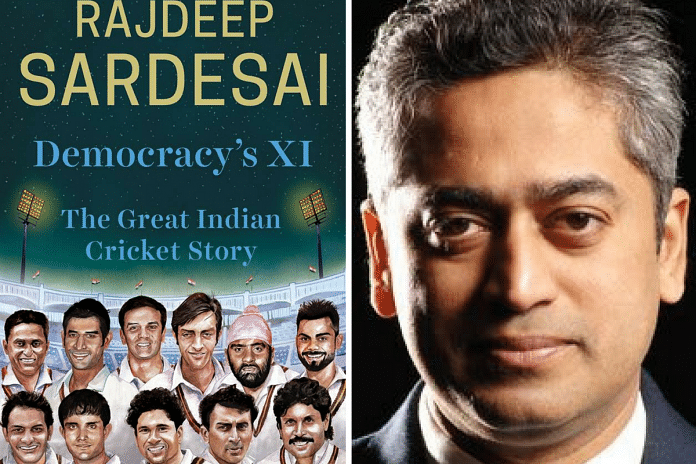Sardesai says his book is a personal choice of 11 individuals who have shaped Indian cricket. But it fails as a chronicle of cricket and its practitioners.
For journalist Rajdeep Sardesai, like so many others in India, cricket and politics are cherished obsessions that bring passion oozing out of each and every word. Through his book ‘Democracy’s XI’, Sardesai attempts to chart the course of Indian cricket’s ascendancy from diffidence to dominance.
However, even at first glance (the cover bears the faces of the XI), many a cricket fan would disagree with Sardesai’s choice, as he misses quite a few obvious legends. He has picked the side not on the basis of statistics, but the sheer force of change these cricketers brought to the way game was played in India. But it features just two proper bowlers.
Even so, Sardesai explains this is not a book about choosing an all-time best Indian cricket XI – it is a personal choice of 11 individuals who he believes shaped Indian cricket and made it the country’s number one sport. He calls this eleven a “baton relay”.
The narrative is not crisp; it turns monotonous after the first few chapters, from one cricketer to the next. Only a long-time cricket aficionado will read it till the end. But if you do, it is a journey from the maidans of Mumbai to the cricket academies of west Delhi via Kolkata and Punjab. The stronghold of cricket has duly shifted from Mumbai to Delhi, with as many as five cricketers from the capital representing India in the same eleven, similar to the erstwhile dominance of Bombay/Mumbai.
Controversial choices
The choice that will generate the most debate, however, is of the author’s father, Dilip Sardesai. Rajdeep reasons that Sardesai senior, born in Margao in Portuguese-ruled Goa, was the first major player to come from a small town, and thus made a lasting impact on Indian cricket. In terms of numbers, too, Dilip Sardesai had decent numbers – 2,001 runs in 30 Tests at an average of 39.23, with five centuries, including two doubles.
However, in this reasoning, Sardesai junior ignores someone like Lala Amarnath, one of the doyens of Indian cricket, who hailed from Kapurthala, Punjab. Amarnath had a much greater impact on the cricket-loving public’s consciousness, having been the first Indian to score a Test century, being the first cricket captain of independent India. He was also the first true ‘commoner’ to be captain – his predecessors had been C.K. Nayudu, a colonel in the army of a princely state, and two royals – the Maharajkumar of Vizianagram and Iftikhar Ali Khan of Pataudi.
Another question that arises out of Sardesai’s choice is that for a team labelled ‘Democracy’s XI’, there is literally one subaltern story he has picked to tell, that of Mohammad Azharuddin. He ends up arguing that “cricket is one of the few largely meritocratic activities in the country, a highly competitive game that mirrors the idealism of our founding fathers and the spirit of our republican Constitution that sought equal opportunity for all”.
But he sticks to choosing bluebloods, middle-class heroes of the bygone era, and modern greats, and ignoring someone like Eknath Solkar, a groundsman’s son from Mumbai’s suburbs, who had a tremendous impact on the game in India through his fielding and close catching, adding an extra dimension to India’s spin threat between 1969 and 1977.
As far as anecdotes are concerned, there’s not much that’s new, except the relationship between former India captain Mahendra Singh Dhoni and BCCI chief N. Srinivasan. Much has been speculated about their business dealings, but Sardesai gets Srinivasan to speak about the relationship, which included the latter using his veto power to overturn chief selector Mohinder Amarnath’s decision to drop Dhoni as captain after a string of poor shows in 2012.
Too much of a stretch
Sardesai calls himself a cricket romantic, but has indulged in gross generalisations and conflation, terming cricket a panacea to the highly-segmented Indian society. Sardesai brings his vast experience in political reporting to the table when he connects the cricket phenomena with India’s political economy. But he goes overboard at times.
For example, on the ‘strained’ relations between Virat Kohli and Anil Kumble, he draws a parallel between Kohli’s unbridled power as captain with the prevailing autocratic political culture, where the power is concentrated in one individual – be it Narendra Modi at the Centre, or regional satraps. But this is where his socio-political speculation loses steam; the captain has always called the shots in Indian cricket.
Similarly, the coming together of Virender Sehwag, Rahul Dravid, Sourav Ganguly, and V.V.S. Laxman to share Sachin Tendulkar’s burden is compared to coalition politics – which is too much of a stretch.
‘Democracy’s XI’ resemble a fan mail, rather than a nuanced book on the game and its practitioners.
‘Democracy’s XI:The Great Indian Cricket Story’ by Rajdeep Sardesai has been published by Juggernaut.



